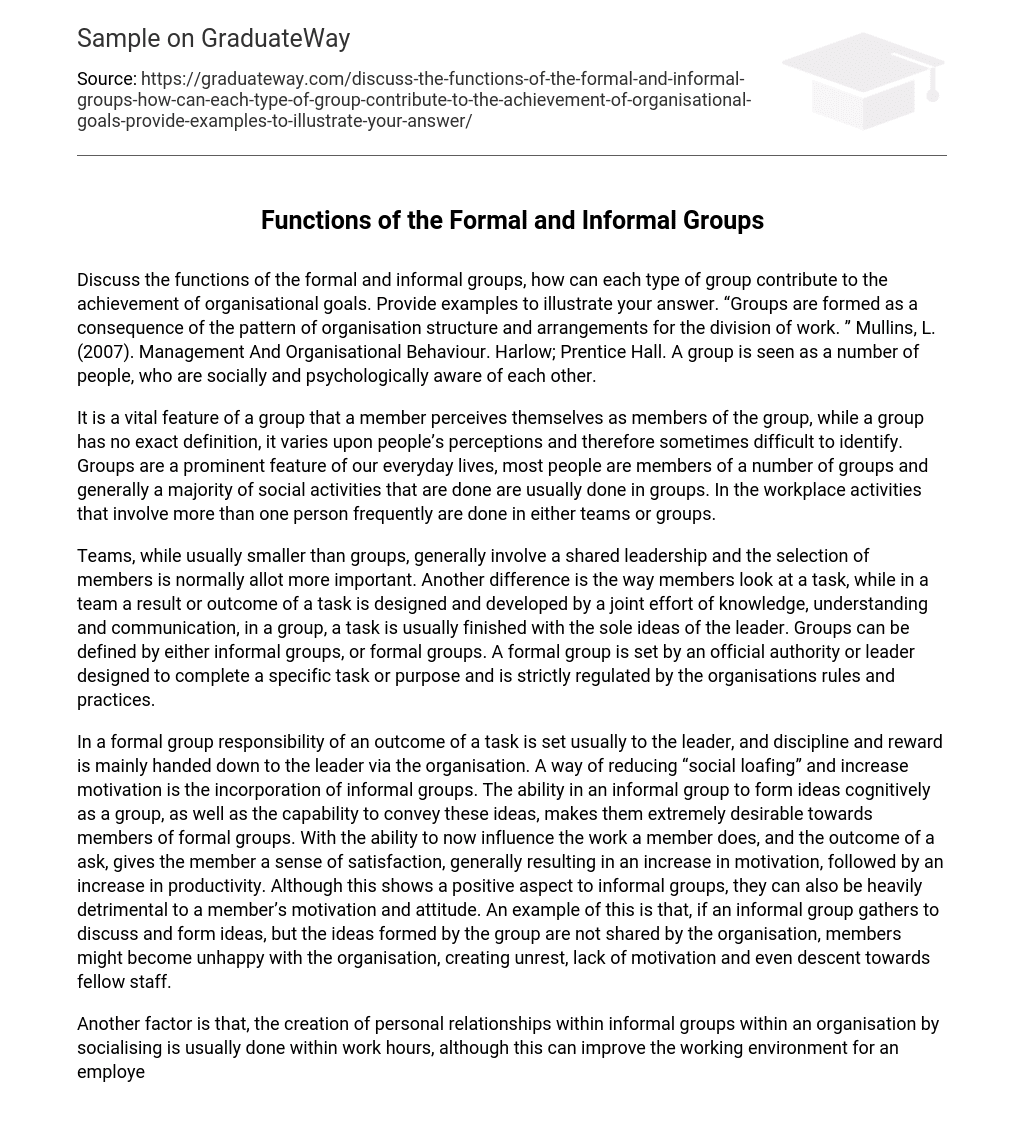Discuss the functions of the formal and informal groups, how can each type of group contribute to the achievement of organisational goals. Provide examples to illustrate your answer. “Groups are formed as a consequence of the pattern of organisation structure and arrangements for the division of work. ” Mullins, L. (2007). Management And Organisational Behaviour. Harlow; Prentice Hall. A group is seen as a number of people, who are socially and psychologically aware of each other.
It is a vital feature of a group that a member perceives themselves as members of the group, while a group has no exact definition, it varies upon people’s perceptions and therefore sometimes difficult to identify. Groups are a prominent feature of our everyday lives, most people are members of a number of groups and generally a majority of social activities that are done are usually done in groups. In the workplace activities that involve more than one person frequently are done in either teams or groups.
Teams, while usually smaller than groups, generally involve a shared leadership and the selection of members is normally allot more important. Another difference is the way members look at a task, while in a team a result or outcome of a task is designed and developed by a joint effort of knowledge, understanding and communication, in a group, a task is usually finished with the sole ideas of the leader. Groups can be defined by either informal groups, or formal groups. A formal group is set by an official authority or leader designed to complete a specific task or purpose and is strictly regulated by the organisations rules and practices.
In a formal group responsibility of an outcome of a task is set usually to the leader, and discipline and reward is mainly handed down to the leader via the organisation. A way of reducing “social loafing” and increase motivation is the incorporation of informal groups. The ability in an informal group to form ideas cognitively as a group, as well as the capability to convey these ideas, makes them extremely desirable towards members of formal groups. With the ability to now influence the work a member does, and the outcome of a ask, gives the member a sense of satisfaction, generally resulting in an increase in motivation, followed by an increase in productivity. Although this shows a positive aspect to informal groups, they can also be heavily detrimental to a member’s motivation and attitude. An example of this is that, if an informal group gathers to discuss and form ideas, but the ideas formed by the group are not shared by the organisation, members might become unhappy with the organisation, creating unrest, lack of motivation and even descent towards fellow staff.
Another factor is that, the creation of personal relationships within informal groups within an organisation by socialising is usually done within work hours, although this can improve the working environment for an employee, from an organisational point of view, it is counterproductive as it is time consuming activity and rarely follows anything constructive towards organisational goals therefore decreasing performance. Work environment; the nature of the task here workers are involved in similar work, share a common task, or face the same problems, this may assist cohesiveness.
The nature of the task may serve to bring people together. _ Physical setting, where members of a group work in the same location or in close physical proximity to each other, this will generally help cohesiveness. Communications; the more easily_ members can communicate freely with each other, the greater the likelihood of group cohesiveness. _ Technology, we can see that the nature of technology and the manner in which work is carried out has an important effect on cohesiveness, and relates closely to the nature of the task, physical setting and communications. The concluding aspect affecting formal groups is the group’s development and maturity. French explains this process of group development through a five stage cycle. Forming is when members are introduced. Storming is when informal groups are developed. Norming is when informal groups have been made and interpersonal relationships are developed. Performing is when interpersonal relationships have been made and task performance is increased. Adjourning is when recognition is achieved and people celebrate accomplishments as well as disbanding. The cycle then repeats itself and returns to the forming stage.
This illustrates the ability to study and mould informal groups to fit organisational tasks. In conclusion, formal groups and informal groups can attribute heavily towards motivation and performance, this can be negative, but generally positive. Mullins, L. (2007). Management and Organisational Behaviour. Harlow; Prentice Hall. Mullins, L. (2002). Management and Organisational Behaviour, 6th edition, Harlow; Prentice Hall. Huczynski, A. Buchanan, D. (2007) Organisational Behaviour. Pearson French, R. (2008). Organisational Behaviour. Chichester; Wiley & sons





